|
Archive for the 'Native American' Category
Simon Maghakyan on 06 Nov 2008
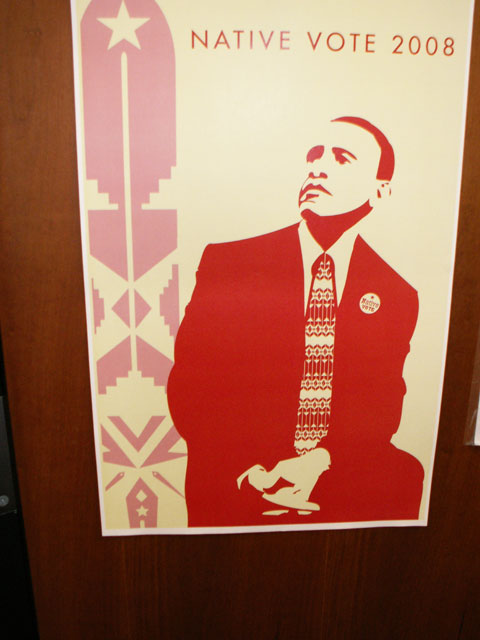
Image: A poster on University of Colorado Denver Professor Glenn Morris’ door.
While Native Americans are United States citizens, they are also considered part of the Fourth World – the Earth’s often invisible indigenous peoples. In a way, Native Americans don’t have much voice in the United States. That’s largely because the “one person, one vote” form of democracy doesn’t always adequately reflect the ideas of the aboriginal people who didn’t really give consent to become part of the United States. But in 2008, Native America seems excited about the US elections more than ever.
I interview Prof. Glenn Morris, a long-time American Indian Movement (AIM) activist and director of the Fourth World Center at the University of Colorado Denver a day after the election.
Morris, who received his law degree from Harvard several years before president-elect Barack Obama did, seems cautiously excited about the next leader of the United States. The indigenous professor says he is happy that he has been proven wrong about his prediction that racism wouldn’t let Obama get elected. He’s worried, though, about false perception of overcoming racism.
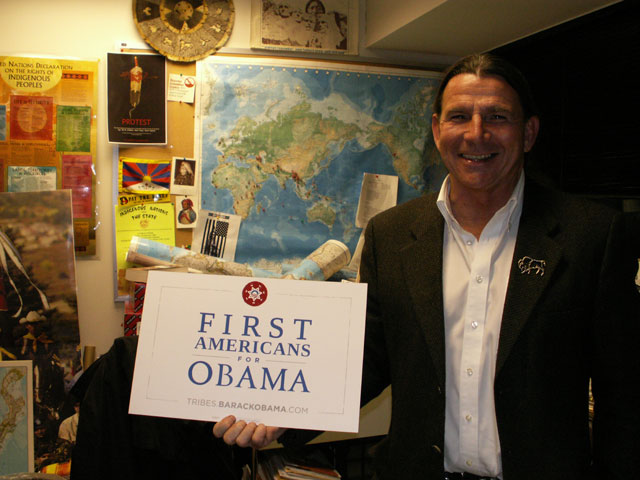
Image: Prof. Glenn Morris at the Fourth World Center (University of Colorado)
“My concern has been the tendency to suggest that Obama’s election demonstrates a post-racial era. The danger of defining race as black and white allows the United States to ignore the country’s original sin – the Doctrine of Discovery.” Morris says that racism will be prevalent until the country “looks at the foundational injustice in the creation” of the United States, with a reference to the genocide against Native Americans.
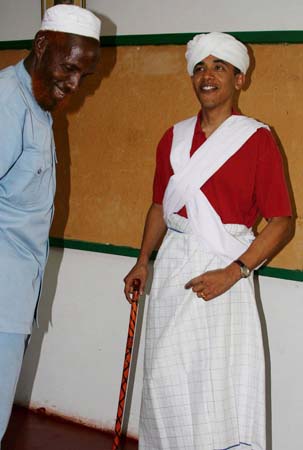 Image: Obama in an indigenous Kenyan dress Image: Obama in an indigenous Kenyan dress
The professor says that there are different Indian voices in the elections. But the Navajo nation, explains Morris, had a role in delivering Mexico (and almost Arizona) for Obama. And while the restless activist says he’s excited about Obama’s idea to have a presidential adviser on Native American issues, he hopes that “Native participation will translate into policy.” In Canada, for instance, the federal government often makes decisions affecting aboriginal communities by consulting with First Nations. Morris thinks that consent, not consultation, should be the level of such communication.
Was the Native vote numerically or symbolically important for Barack Obama? Morris says Obama’s outreach to Americans Indians was “partly personal, partly ideological, and partly tactical.”
Obama “may not understand [Native American issues] entirely,” says Glenn Morris, but America’s 44th president seems the only leader so far “who may kind of get it.”
Simon Maghakyan on 28 Sep 2008
Please fax a brief letter to Senate Indian Affairs Committee urging that a hearing be held on these issues as soon as possible. The Committee fax number is 202-228-2589.
Advocates for the Protection of Sacred Sites; Save the Peaks Coalition; Indigenous Environmental Network; International Indian Treaty Council; Seventh Generation Fund; Vallejo Inter-Tribal Council; Morning Star Institute
For Immediate Release: September 25, 2008
Tribal Nations, Native Rights Organizations, and Social/Environmenta l Justice Allies Call on Congress and Administration to Immediately Address Tribal Sacred Lands Protection
Senate Indian Affairs Committee & Other Congressional Committees Urged to Convene Hearings on Sacred Lands
Indian Country, USA— Tribal Nations, Native rights organizations, and social/environmenta l justice allies are calling on the U.S. Senate Indian Affairs Committee and other Congressional Committees to conduct hearings concerning federal land management practices that threaten or destroy Tribal sacred lands. The Advocates for the Protection of Sacred Sites, The Save the Peaks Coalition, Indigenous Environmental Network, International Indian Treaty Council, Seventh Generation Fund, Vallejo Inter-Tribal Council, and Morning Star Institute have joined together to address the lack of federal government cooperation and consultation with Tribes in balancing destructive corporate development of Tribal ancestral lands an d honoring Tribal rights and needs. The groups are also calling on the Advisory Council on Historic Preservation to investigate federal government non-compliance with Tribal consultation requirements and to assist in immediately remedying the problems. “Corporate development of federal lands that overlap sacred Tribal ancestral lands not only further the desecration and destruction of sacred places and areas which Indigenous Peoples have traditionally used and safeguarded, but harm longstanding and positive Tribal social and cultural structures, increase threats to endangered and threatened species, and cause environmental destruction,” stated Mark LeBeau, Co-Chair of the Advocates for the Protection of Sacred Sites. “The protection and preservation of sacred places are essential to the practice of Indigenous Peoples’ freedom of religions, a fundamental human right which is recognized by both federal and international law.”
The
United Nations Declaration on the Rights of Indigenous Peoples was adopted by the UN General Assembly on September 13, 2007. This Declaration represents the dynamic development of international legal norms and sets an important standard for the treatment of Indigenous Peoples by states. It is a significant tool towards eliminating human rights violations against the planet’s 370 million Indigenous Peoples and assisting them in combating discrimination and marginalization. Article 12 of the Declaration affirms that “Indigenous peoples have the right to manifest, practice, develop and teach their spiritual and religious traditions, customs and ceremonies and the right to maintain, protect, and have access in privacy to their religious and cultural sites.””Congress and the Advisory Council for Historic Preservation must intervene where the Bureau of Land Management (BLM) and other federal agencies have fallen short in their fiduciary responsibilities to federally-recognize d Tribes, including working cooperatively and constructively with Tribes to resolve disputes,” said Radley Davis, Co-Chair of the Advocates for the Protection of Sacred Sites.
On July 11, 2008, more than 1,000 Native rights and environmental justice advocates arrived in Washington, DC after walking across the US to raise awareness about key issues affecting Native peoples and the environment. The successful journey, known as the Longest Walk 2, delivered a 30-page manifesto and list of demands to Congress, which included the protection of sacred places and climate change mitigation.
House Judiciary Chair, US Representative John Conyers (D-MI) promised representatives from the Longest Walk 2 that their issues would be addressed but set no timetable. “The Committee on the Judiciary will hold hearings on each one of these items that you have outlined here,” stated Rep. Conyers.
Tribal Nations and Native rights organizations are aware of hundreds of threatened sacred places throughout the US and are highlighting two critical threatened sacred places as evidence for immediate political action: The Medicine Lake Highlands located in California and the San Francisco Peaks located in Northern Arizona.
The Medicine Lake Highlands, northeast of Mt. Shasta, are sacred to the Pit River, Wintu, Karuk, Modoc, Shasta, and other Tribal nations. The Pit River people believe that the Creator and his son bathed in the lake after creating the earth, and then the Creator placed healing medicine in the lake. In the 1980s the BLM gave energy development leases in the Highlands to developers, without first conducting adequate environmental review and consulting any of the Tribes that would be affected by the projects. Developers such as Calpine Energy Corporation have used any tactic that money could buy to try to achieve their goal of building massive power plants in the sacred Highlands to harness geothermal energy, including activating teams of20lawyers, lobbying state and federal representatives, buying-off some adversaries, and information spinning.
“The developers are attempting to move ahead in spite of the fact that project-drilling in the Highlands would likely release dangerous chemicals, including arsenic, chromium, and hydrogen sulfide, into the surface and ground waters that Californians and all other living things in this region rely upon,” stated James Hayward, Co-Chair of the Advocates for the Protection of Sacred Sites. “This proposed project must be stopped and the US government must assist in this effort.”
In November 2006, the 9th Circuit Court of Appeals ruled that the federal agencies neglected their fiduciary responsibilities to the Pit River Nation by violating the National Environmental Protection and the National Historic Preservation Acts and that the agencies never took the requisite “hard look” at whether th e Highlands should be developed for energy at all. As a result, the court rejected the extension of leases that would have allowed Calpine to build geothermal plants and ordered judgment in favor of Pit River. Now BLM and Calpine are at it again as they prepare to attempt to conduct geothermal resource exploration in the sacred Glass Mountain region of the Highlands. BLM contends that the ruling was not explicative enough and so it is moving forward with the exploration. The Advocates for the Protection of Sacred Sites strongly oppose BLM’s reinterpretation of the ruling and will stop the agency.
Louis Gustafson, Citizen of the Pit River Nation, says, ”The government has agreements not to bomb holy mosques when they’re at war, but we have to go through all these hoops just to protect our holy place.”
Arizona’s San Francisco Peaks are recognized internationally as a sacred place. The Peaks are a unique ecological island and are held holy by more than 13 Native American Nations. Arizona Snowbowl Ski Resort, located on the holy Peaks, is attempting to expand development, clear-cut acres of old growth trees, and make fake snow from treated sewage effluent, which has been proven to have harmful contaminants. The US Forest Service manages the San Francisco Peaks as public land and has faced multiple lawsuits by the Navajo Nation, Hopi, White Mountain Apache, Yavapai Apache, Hualapai, and Havasupai tribes, as well as the Sierra Club, Flagstaff Activist Network, Center of Biological Diversity, and others after it initially approved the proposed ski area development in 2005.
On August 8, 2008 the 9th Circuit of Appeals overturned a previous court ruling stopping the proposed development. The case is expected to be appealed to the Supreme Court.
“We have no guarantee for the protection for our religious freedom when it comes to government land use decisions,” stated Klee Benally of the Save the Peaks Coalition. “This case underscores the fact that we need legislative action to ensure protection for places held holy by Native American Tribes. Federal land management policies are inconsistent when addressing Native American religious practice relating to sacred places. From the San Francisco Peaks, Medicine Lake Highlands, Yucca Mountain, Bear Butte, Mt. Taylor, Mt. Graham and the hundreds of additional sacred places that are threatened or are currently being desecrated, we need consistent protective action now.”
“The corporate projects proposed in the Medicine Lake Highlands and on San Francisco Peaks must be stopped. Key federal lawmakers and administration officials must work more rigorously with Tribes to ensure adequate cooperation and consultation on proposed projects that overlap Tribal sacred lands,” stated Radley Davis. “Our call for hearings is a critical measure that must be taken seriously to ensure that balancing corporate and agency development of Tribal ancestral lands and the needs and rights of Indigenous Nations are honored.”
Please fax a brief letter to Senate Indian Affairs Committee urging that a hearing be held on these issues as soon as possible. The Committee fax number is 202-228-2589.
Simon Maghakyan on 19 Aug 2008
Native American activist Russell Means, known for long-time activism and for the recent controversial declaration of Lakota independence, is looking forward to August 25. But he won’t be in Denver to attend the first day of the Democratic National Convention or protest Columbus Day holiday, which was first celebrated in the Mile High City in 1907.
Instead, “America’s angriest Indian” will be in his native land with a group of supporters protesting what they consider violation of a federal treaty.
In the words of Republic of Lakotah website:
In the tradition of Gandhi and Martin Luther King, Russell Means, the Chief Facilitator of the Republic of Lakotah, is organizing a group of Lakotah Indians to enter Sheridan Lake Recreation Area near Rapid City, South Dakota, refuse to pay the admission fee, and fish without paying the license fee. Means claims that Lakotah retained the right to fish and pass in the 1851 Fort Laramie Treaty territory and that those rights continue today and backed by Article VI of the Constitution of the united states of America.
The event, which is being billed as the Lakotah Freedom Fishing Day, is about much more than the admission fee or the fishing license fee; it is about getting the South Dakota and United States governments to follow their own laws. Means said, “After having been an occupied nation for over 150 years, we have asked the United States government to leave our country. Meanwhile, until the United States Government leaves Lakotah territory we will take every opportunity to insist it follow its own laws and that its states do the same.”
Lakotah have given notice to Larry Long, the Attorney General of South Dakota, of its plans for this event. Means said he has not heard from Long yet and does not know if the state plans on allowing the Indians to fish and pass or if the park rangers will issue citations or arrest any of the Lakotah fishermen. Means plans to call in federal marshalls to enforce the treaty rights. Means said, “According to the Civil Right Act, federal marshalls should arrest any state official who tries to stop Lakotah from entering the park and fishing. However, if the United States ignores its own laws to deny Lakotah rights, it will certainly not be the first time.”
This historic event is planned for Monday, August 25th, at 1:00 p.m.
Simon Maghakyan on 09 Aug 2008
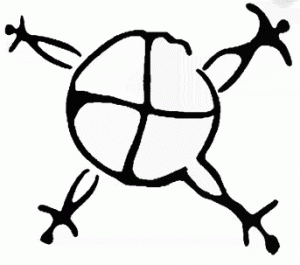 August 9 is the United Nation’s International Day of the World’s Indigenous Peoples, yet many people don’t know what “indigenous peoples” means. Ironically, the ongoing war in South Ossetia is of interest in indigenous studies. August 9 is the United Nation’s International Day of the World’s Indigenous Peoples, yet many people don’t know what “indigenous peoples” means. Ironically, the ongoing war in South Ossetia is of interest in indigenous studies.
Even though the notion of “indigenous peoples” sometimes may be vague, a definition of indigenous peoples that most scholars agree with was provided by the United Nations Special Rapporteur on minority and indigenous communities. Indigenous peoples, according to that articulation, are “…those which having a historical continuity with pre-invasion and pre-colonial societies that developed on their territories, consider themselves distinct from other sectors of societies now prevailing in those territories, or parts of them. They form at present non-dominant sectors of society and are determined to preserve, develop, and transmit to future generations their ancestral territories, and their ethnic identity, as the basis of their continued existence as peoples, in accordance with their own cultural patterns, social institutions and legal systems.”
I am currently editing an article that talks about Armenians and indigenous peoples. While Armenians, in general, have been considered “indigenous,” given that almost every nation in the Middle East and the Caucasus considers themselves native to their lands, the question of indigenous can be very controversial.
The ongoing war in South Ossetia and Georgia is a good example. While both Georgians and Ossetians have indigenous claims, both parts see each other as trying to steal a land that “belongs to them.” This idea of a land belonging to someone is, in principle, against core indigenous values (especially that of the ones in the western hemisphere). As one Native American chief has said, “the earth doesn’t belong to us, we belong to the earth.”
Some resources on indigenous peoples:
Cultural Survival Magazine
United Nations Permanent Forum on Indigenous Issues
Fourth World Center
Simon Maghakyan on 21 Dec 2007
You may never hear this on CNN, but the North American continent doesn’t consist of Canada, Mexico and the U.S. any longer. You need to add one more country to the list – Lakota.
Yes, the leaders of the Native American Lakota nation have formalized their independence from the United States by dropping from treaties with the United States that they say were never implemented in the first place.
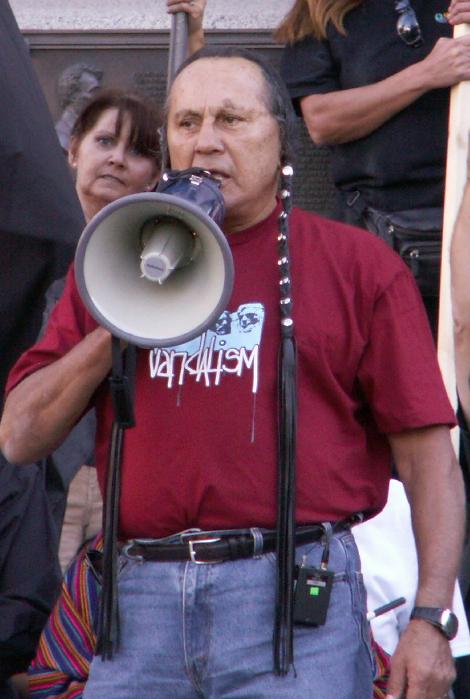
Russel Means talking during Columbus Day protest in Denver
According to Agence France Press:
[…]
“We are no longer citizens of the United States of America and all those who live in the five-state area that encompasses our country are free to join us,” long-time Indian rights activist Russell Means told a handful of reporters and a delegation from the Bolivian embassy, gathered in a church in a run-down neighborhood of Washington for a news conference.
A delegation of Lakota leaders delivered a message to the State Department on Monday, announcing they were unilaterally withdrawing from treaties they signed with the federal government of the United States, some of them more than 150 years old.
[…]
Lakota country includes parts of the states of Nebraska, South Dakota, North Dakota, Montana and Wyoming.
The new country would issue its own passports and driving licences, and living there would be tax-free — provided residents renounce their US citizenship, Means said.
The declaration of Lakota’s independence was arguably made possible by the recently-adopted United Nations Declaration on Indigenous Rights. I have commented on the declaration before arguing it lacks condemnation of the worst threat posed to indigenous people – cultural genocide. But I guess the declaration at least inspires indigenous nations to strive for more rights.
And in case you are thinking “who the hell would want to secede from America” be advised that the Lakota reservation is one of the poorest places in the world. The Lakota people die the youngest in the entire world, excluding those who die from AIDS in Africa.
Oppression at the hands of the US government has taken its toll on the Lakota, whose men have one of the shortest life expectancies — less than 44 years — in the world.
Lakota teen suicides are 150 percent above the norm for the United States; infant mortality is five times higher than the US average; and unemployment is rife, according to the Lakota freedom movement’s website.
Rape of Native American women (overwhelmingly by whites) is three times higher in the United States than that of the rape of all other women.
According to the official website of the Lakota delegates who visited Washington D.C. to drop from the treaties:
We are the freedom loving Lakota from the Sioux Indian reservations of Nebraska, North Dakota, South Dakota and Montana who have suffered from cultural and physical genocide in the colonial apartheid system we have been forced to live under.
We are continuing the work that we were asked to do by the traditional chiefs and treaty councils, and 97 Indian Nations at the first Indian Treaty Council meeting at Standing Rock Sioux Indian Country in 1974.
During the week of December 17-19, 2007, we traveled to Washington DC and withdrew from the constitutionally mandated treaties to become a free and independent country. We are alerting the Family of Nations we have now reassumed our freedom and independence with the backing of Natural, International, and United States law.
We do not represent those BIA or IRA governments beholden to the colonial apartheid system, or those “stay by the fort” Indians who are unwilling claim their freedom.
And a poem by Dennis Banks quoted in my most favorite book – Mary Crow Dog’s Lakota Woman:
They call us the New Indians
Hell, we are the Old Indians,
the landlords of this continent,
coming to collect the rent.
Simon Maghakyan on 27 Apr 2007

© Blogian 2007 – Pow Wow Native American Festival in Denver
In July 2006 an Alaska Native woman in Fairbanks reported to the police that she had been raped by a non-Native man. She gave a description of the alleged perpetrator and city police officers told her that they were going to look for him. She waited for the police to return and when they failed to do so, she went to the emergency room for treatment. A support worker told Amnesty International that the woman had bruises all over her body and was so traumatized that she was talking very quickly. She said that, although the woman was not drunk, the Sexual Assault Response Team nevertheless “treated her like a drunk Native woman first and a rape victim second”. The support worker described how the woman was given some painkillers and some money to go to a non-Native shelter, which turned her away because they also assumed that she was drunk: “This is why Native women don’t report. It’s creating a breeding ground for sexual predators.”
The paragraph above is from a study by Amnesty International, released on April 24, 2007, that has concluded, “One in three Native American or Alaska Native women will be raped at some point in their lives. Most do not seek justice because they know they will be met with inaction or indifference.”

© Blogian 2007 – Pow Wow Native American Festival in Denver
According to the report, Native American women are about 3 times more likely to be raped in America than other women. Moreover,
According to the US Department of Justice, in at least 86 per cent of reported cases of rape or sexual assault against American Indian and Alaska Native women, survivors report that the perpetrators are non-Native men. (This is in the case when most rapes in America are perpetrated by the same racial group – Blogian.)
The violation against Native American women is shocking and reminds of all the trouble and suffering that these people have been going through for hundreds of years. Reading Lakota Woman earlier this year – a book by Mary Crow Dog about her experience as a Native American woman – I could not believe that even in the 1970s there was cultural genocide going on against the Natives. But it turns out it is going on today, in 2007.

© Blogian 2007 – Pow Wow Native American Festival in Denver
I think the rape of Native American women is continuation of the cultural genocide. But whatever you name it, it is happening and needs immediate reaction, especially given the Amnesty International charge that the US government is to blame for not protecting these women and children.
Interestingly, I brought similar topic up with my Native American studies professor Glenn Morris two weeks ago when I asked him what was the situation with human trafficking among Native American reservations (having found out about domestic human trafficking in the US, I had figured out that most vulnerable of US communities – the “Indian” reservations – would be a source for violating women and children). Prof. Morris didn’t know whether there was human trafficking, but he said there were lots of rape.
The full study is available at http://web.amnesty.org/library/Index/ENGAMR510352007.
Simon Maghakyan on 01 Apr 2007

Last Friday, March 23, 2007, when I was very sick after having returned from snowy Montreal, I decided to go to POW WOW in Denver with my Mom.

POW WOW is a Native American festival where hundreds of nations across America gather to dance, sing and get to know each other.

First time in my life I saw real America – the real beauty of America with her tortured children who were celebrating survival, their survival.

Glenn Morris, indigenous politics professor at the University of Colorado at Denver, told our class this past Thursday that when he was taken to a Native American reservation in Costa Rica in 1986, he felt embarrassed that he had been told in all his academic life (plus a law degree from Harvard) that there were no Native Americans in Costa Rica. His new friends in Costa Rica started to laugh when Prof. Morris made his confession. The Native Costa Ricans told him not to worry – they, too, thought there were no Indians left in America.

And perhaps most people in the world have no idea about festivals like POW WOW. Neither do most people who live in Colorado. Most of the audience were Native Americans themselves, who had traveled to see their brothers and sisters dance and sing. Where was white America? I guess in AMCs or other movie theaters to watch “300” in order to reaffirm their hatred for the Iranians, or the savage Persians.
But in POW WOW, I did not care about white America. I was in real America; I was with the real landlords of my apartment who were there to show me the beauty of survival; who were there to tell me that no matter what and no matter when, genocide survival is inevitable and will be celebrated one day.
My romanticized amazement for Native America was shared by the person I had went with – my Mom. She wanted to be photographed with every Native American she saw. For me it meant taking photographs every minute of my presence in POW WOW at the Denver Coliseum.

Surprisingly, she now wants me to post her photographs at Blogian. And since it is April 1 today, why not?


Well, I can’t post the rest of the 270 photographs; the internet is too slow…
But I have to post this one! This photo is from yesterday. My Mom had mask on her face and she reminded me of POW WOW. So I asked her where the Navajo souvenir arrow we bought at the festival was. When she brought it, I took this photo.

|
|

 Image: Obama in an indigenous Kenyan dress
Image: Obama in an indigenous Kenyan dress
 August 9 is the United Nation’s
August 9 is the United Nation’s 










